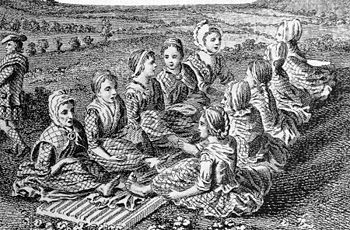
Waulking song
Encyclopedia

A waulking session often begins with slow-paced songs, with the tempo increasing as the cloth becomes softer. As the singers work the cloth, they gradually shift it to the left so as to work it thoroughly. A tradition holds that moving the cloth counter-clockwise is unlucky.
Typically one person sings the verse, while the others join in the chorus. As with many folk music forms, the lyrics of waulking songs are not always strictly adhered to. Singers might add or leave out verses depending on the particular length and size of tweed being waulked. Verses from one song might appear in another, and at times the lead singer might improvise to include events or people known locally.
The chorus to many waulking songs consists of meaningless vocables, serving a function similar to 'tra la la' or 'hey hey hey' in other song forms.
Some waulking songs have a strict verse-and-chorus structure. In other songs, the vocables are sung at the end of each line of a verse. In a song like S Fliuch an Oidhche ('Wet is the Night'), also known as Coisich a Rùin ('Come on, My Love'), the last two lines of one verse become the first two lines of the following one.
A tradition holds that it's bad luck to repeat a song during a waulking session, which may explain in part both the many verses of some songs and the large number of songs.
While waulking is a common practice across the world, it is only in Scotland that music became so strongly associated with it as to become an important cultural
Culture of Scotland
The culture of Scotland refers to the patterns of human activity and symbolism associated with Scotland and the Scottish people. Some elements of Scottish culture, such as its separate national church, are protected in law as agreed in the Treaty of Union, and other instruments...
feature.
Waulking is rare in Scotland today, mostly confined to the Outer Hebrides
Outer Hebrides
The Outer Hebrides also known as the Western Isles and the Long Island, is an island chain off the west coast of Scotland. The islands are geographically contiguous with Comhairle nan Eilean Siar, one of the 32 unitary council areas of Scotland...
where it is carried out as a celebration of heritage. The last true waulking (for the purpose of making cloth) is believed to have occurred during the 1950s.
During the Highland clearances
Highland Clearances
The Highland Clearances were forced displacements of the population of the Scottish Highlands during the 18th and 19th centuries. They led to mass emigration to the sea coast, the Scottish Lowlands, and the North American colonies...
, traditional methods of waulking spread with the Scottish diaspora. In Nova Scotia
Nova Scotia
Nova Scotia is one of Canada's three Maritime provinces and is the most populous province in Atlantic Canada. The name of the province is Latin for "New Scotland," but "Nova Scotia" is the recognized, English-language name of the province. The provincial capital is Halifax. Nova Scotia is the...
, and in particular on Cape Breton Island
Cape Breton Island
Cape Breton Island is an island on the Atlantic coast of North America. It likely corresponds to the word Breton, the French demonym for Brittany....
, waulking is known as milling. Although in Scotland women waulked cloth, in Nova Scotia both men and women took part in milling frolics. The practice continues as a cultural celebration today.

